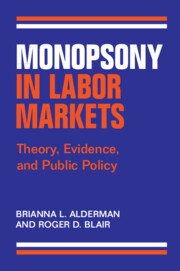Book contents
- Monopsony in Labor Markets
- Monopsony in Labor Markets
- Copyright page
- Dedication
- Contents
- Figures
- Tables
- Preface
- Acknowledgments
- 1 Monopsony in the Labor Market
- 2 The Economics of Monopsony
- 3 Empirical Evidence of Monopsony in Labor Markets
- 4 Antitrust Policy in the United States
- 5 The Intended and Unintended Victims of Monopsony
- 6 Collusion on Wages and Terms of Employment
- 7 No-Poaching Agreements
- 8 Noncompete Agreements
- 9 Unions and Collective Bargaining
- 10 Monopsony and Merger Policy
- 11 Closing Thoughts
- Index
2 - The Economics of Monopsony
Published online by Cambridge University Press: 08 February 2024
- Monopsony in Labor Markets
- Monopsony in Labor Markets
- Copyright page
- Dedication
- Contents
- Figures
- Tables
- Preface
- Acknowledgments
- 1 Monopsony in the Labor Market
- 2 The Economics of Monopsony
- 3 Empirical Evidence of Monopsony in Labor Markets
- 4 Antitrust Policy in the United States
- 5 The Intended and Unintended Victims of Monopsony
- 6 Collusion on Wages and Terms of Employment
- 7 No-Poaching Agreements
- 8 Noncompete Agreements
- 9 Unions and Collective Bargaining
- 10 Monopsony and Merger Policy
- 11 Closing Thoughts
- Index
Summary
We begin with the basic economic theory of monopsony. In this chapter, we present the economic models of (1) pure monopsony, (2) the dominant employer, and (3) oligopsony. In these cases, we show that profit maximization results in ill effects for workers. These include reduced compensation, reduced employment, and the redistribution of wealth from workers to employers. We also show that social welfare is reduced below the level that society would have experienced in the absence of monopsony.
- Type
- Chapter
- Information
- Monopsony in Labor MarketsTheory, Evidence, and Public Policy, pp. 15 - 31Publisher: Cambridge University PressPrint publication year: 2024

